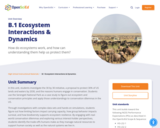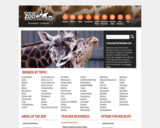
Learn facts about the African wild dog. Includes audio narration of text.
- Subject:
- Science
- Material Type:
- Textbook
- Provider:
- Unite for Literacy
- Provider Set:
- Conservation
- Date Added:
- 10/03/2023

Learn facts about the African wild dog. Includes audio narration of text.

This article highlights resources related to water from the American Museum of Natural History and at-home activities on ice and water.

How do ecosystems work, and how can understanding them help us protect them? In this unit, students investigate the 30 by 30 initiative, a proposal to protect 30% of US lands and waters by 2030, and the reasons humans engage in conservation. Students use the Serengeti National Park as a case study to figure out ecosystem and conservation principles and apply those understandings to conservation dilemmas in the US.
OpenSciEd content is highly rated in EdReports and is aligned to NGSS standards.

Students conduct a hands-on investigation to determine how matter, changing state, effects the property of weight. Students will collect data and graph their results. Resources include step by step instructions, a data worksheet, videos of the lesson in action, and examples of student work.

Biology 2e is designed to cover the scope and sequence requirements of a typical two-semester biology course for science majors. The text provides comprehensive coverage of foundational research and core biology concepts through an evolutionary lens. Biology includes rich features that engage students in scientific inquiry, highlight careers in the biological sciences, and offer everyday applications. The book also includes various types of practice and homework questions that help students understand—and apply—key concepts. The 2nd edition has been revised to incorporate clearer, more current, and more dynamic explanations, while maintaining the same organization as the first edition. Art and illustrations have been substantially improved, and the textbook features additional assessments and related resources.


By the end of this section, you will be able to do the following:
Identify new technologies and methods for describing biodiversity
Explain the legislative framework for conservation
Describe principles and challenges of conservation preserve design
Identify examples of the effects of habitat restoration
Discuss the role of zoos in biodiversity conservation

By the end of this section, you will be able to do the following:
Define biodiversity in terms of species diversity and abundance
Describe biodiversity as the equilibrium of naturally fluctuating rates of extinction and speciation
Identify historical causes of high extinction rates in Earth’s history

By the end of this section, you will be able to do the following:
Identify chemical diversity benefits to humans
Identify biodiversity components that support human agriculture
Describe ecosystem services

By the end of this section, you will be able to do the following:
Identify significant threats to biodiversity
Explain the effects of habitat loss, the introduction of exotic species, and hunting on biodiversity
Identify the early and predicted effects of climate change on biodiversity


Biology is designed for multi-semester biology courses for science majors. It is grounded on an evolutionary basis and includes exciting features that highlight careers in the biological sciences and everyday applications of the concepts at hand. To meet the needs of today’s instructors and students, some content has been strategically condensed while maintaining the overall scope and coverage of traditional texts for this course. Instructors can customize the book, adapting it to the approach that works best in their classroom. Biology also includes an innovative art program that incorporates critical thinking and clicker questions to help students understand—and apply—key concepts.

Paul Andersen explains how energy is conserved within a system. In both macroscopic and microscopic collisions, the amount of energy before the collision is equal to the amount after. He then defines heat as energy transfer between objects with different temperatures. He explains how heat is transferred via conduction, convection, and radiation. [11:12]

In the following video Paul Andersen explains how linear momentum is conserved in all collisions. In completely elastic collisions the kinetic energy of the objects is also maintained. Several examples and demonstrations are included. [7:18]

This resource provides information about forestry and conservation careers. The page contains nature of the work, training, wages, and outlook.

Complete description of careers in logging, including loggers, fallers, buckers, equipment operators, choke setters and riggers, sorters, log graders and scalers, and others who work in the wood harvesting occupations. Page contains nature of the work, training, wages, and outlook.

Jesse loves animals. She lives in California and is checking out where different animals live. Join along and learn about conservation with her.

Welcome to the Zoo's Online Resource Library. Use the search box above to explore our growing collection of digital resources. Check the navigation bar at the top of the page and the categories below for more search options. If you’re an educator, click Lesson Plans.

This article from the free online magazine Beyond Weather and the Water Cycle provides appropriate science lessons for Grades K-5. The focus is on acquainting young learners with climate-change concepts that are not too complex for their grade level and will not frighten them. In each issue, the magazine develops articles around one of the seven essential principles of climate science. The author believes early lessons about water availability and extreme weather events will prepare students for complex climate concepts they will encounter in later grades.